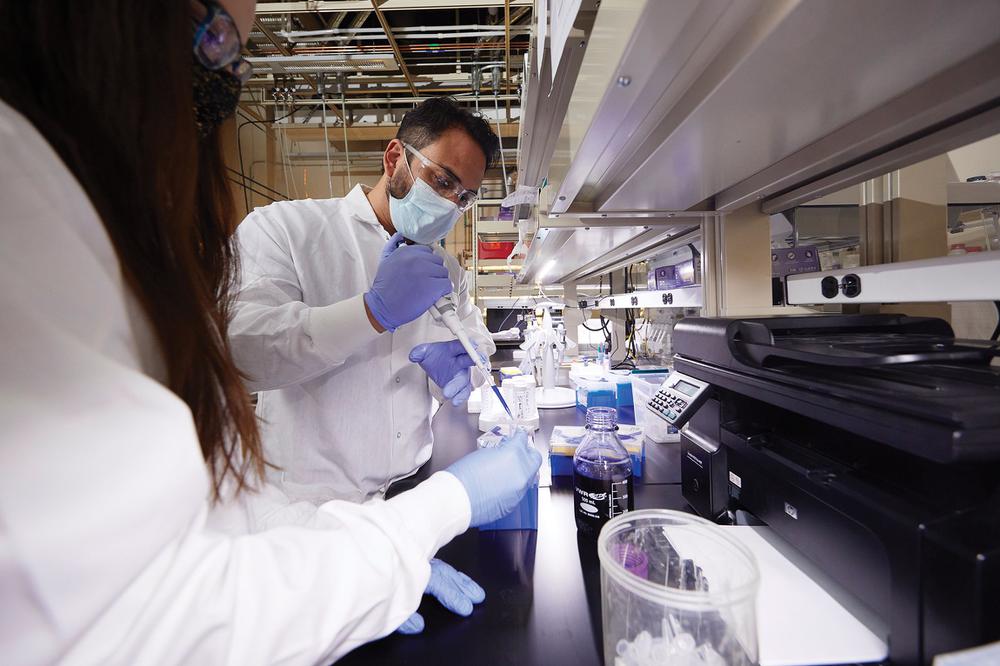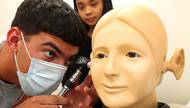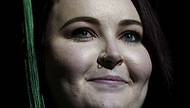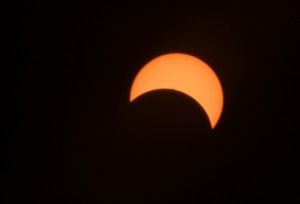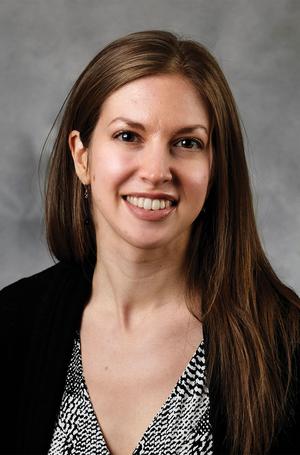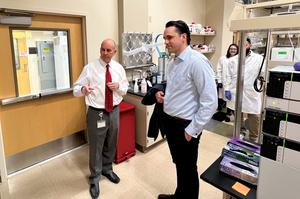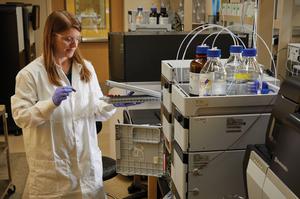Home to a shiny school of medicine and a developing “medical district,” Southern Nevada has bolstered its medical bona fides in recent years. For researcher Samantha John, the region’s diverse population was another key element drawing her here.
“I’m particularly interested in health disparities in neurodegenerative disorders,” says John, an assistant professor in UNLV’s department of brain health. “So it was important for me to find a city that is ethnically and racially diverse.”
John has embarked on a three-year research project studying how race and ethnicity influence patient-reported outcomes and diagnoses of neurodegenerative ailments. Hers is just one of the neuroscience research projects made possible by a recent $11.3 million grant renewal from the National Institutes of Health to UNLV and Las Vegas’ Cleveland Clinic Lou Ruvo Center for Brain Health.
That infusion follows an $11.1 million initial grant, awarded to UNLV and the Ruvo Center in 2015 for the development of a center for neuroscience research. The resulting department of brain health, part of UNLV’s School of Integrated Health Services, helped bring researchers like John to town.
UNLV and the Ruvo Center also jointly opened the Center for Neurodegeneration and Translational Neuroscience (CNTN). A range of research studies have blossomed there, says Aaron Ritter, staff neuropsychiatrist at the Ruvo Center and co-lead on the grant. The studies will continue into Phase 2—from work on Alzheimer’s effects and potential treatments to ways of detecting the disease with different biomarkers, such as eye retinas or blood samples.
The local community can help drive that research forward, Ritter says.
“Nevada is one of the states with the fastest-growing Alzheimer’s Disease populations,” he says. “As people move here, and the disease is so common among people over age 65, it allows the people of Nevada to contribute to meaningful research.”
According to the Alzheimer’s Association, Nevada was home to 49,000 Alzheimer’s patients in 2020. By 2025, that number is expected to grow to 64,000—an increase of 30.6%—and Nevada is projected to rank third among all states by then. Alzheimer’s Disease is the sixth-leading cause of death in the U.S., according to the National Institute on Aging.
The CNTN has drawn in hundreds of Alzheimer’s patients for annual tests involving brain scans and blood samples, and some have been participating in studies for seven years, says grant co-lead Jefferson Kinney, founding chair of UNLV’s department of brain health. According to Ruvo Center statistics, the CNTN has enrolled more than 230 participants as it has grown and expanded from a single study in 2015 to 13 studies in 2022.
Data collected from those participants also has value in the wider field of neuroscience. It can advance research and help to better understand and treat neurodegenerative diseases, researchers say.
“That’s a living and breathing database,” Ritter says, “that researchers—not only from UNLV but all over the United States and the world—can use to test new theories, develop research protocols and to really help us advance Alzheimer’s Disease research. The clinical cohort is really at the heart of it.”
For researchers like John, working with such a diverse group of subjects helps her better understand how neurodegenerative diseases are diagnosed, measured and treated in real life.
“When we’re talking about research, for the vast majority of clinical or medical research, participant samples tend to be, by and large, non-Hispanic whites,” John says. “They tend to be individuals with a high level of education, so some college or college degree. They tend to be English speakers. And they tend to be individuals with higher income levels.
“It is certainly not a sample that represents what our country really looks like, nor does it represent what those who suffer from [neurodegenerative] disease look like.”
Nevada also offers access to patients from rural areas, which could prove important to researchers. “The experience of people in urban versus rural settings may have a difference in how Alzheimer’s occurs and the kind of outcomes that are associated with the disease,” Ritter says.
The type of grant received by UNLV and the Ruvo Center—a Center for Biomedical Research Excellence (COBRE) award—is geared toward developing faculty and enhancing research infrastructure in historically underfunded states. Kinney says the goal is for researchers to continue their work independently after three or four years of grant funding.
So far, three junior scientists who started with grant funding have advanced from preliminary to advanced scientist status and are now running their own laboratories focused on different aspects of Alzheimer’s or Parkinson’s disease. Research has gained traction, too; more than 100 papers have cited the grant, and data from the CNTN has been presented at national conferences, according to Ruvo Center data.
“It’s one of those great examples where you get a bunch of people from several different domains working together,” Kinney says. “It continues to produce dividends in advancing research, advancing researchers and advancing clinical care.”
Kinney and Ritter invite anyone over the age of 55— whether or not they have a neurodegenerative disease—to participate in CNTN studies, contribute to science and learn about their own brain health. Email [email protected] or visit clevelandclinic.org/nevadaresearch for more information.
Click HERE to subscribe for free to the Weekly Fix, the digital edition of Las Vegas Weekly! Stay up to date with the latest on Las Vegas concerts, shows, restaurants, bars and more, sent directly to your inbox!
